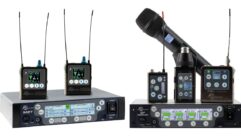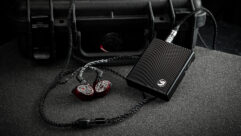

POSSE Audio In-ear Monitor System Review
Apr 6, 2012 3:03 PM,
Reviewer: John McJunkin
A personal monitor mixer that strikes a balance between simple and sophisticated.
A magical solution for the nightmare of monitor mixing, the personal monitor mixer has become more common over the past 15 to 20 years, en route to reaching technical maturity and substantial levels of acceptance and adoption. POSSE Audio has introduced its Personal On Stage Sound Environment (POSSE) system, which appears to me to land right in that sweet spot that’s not too complex, simple, or expensive.
These units range from simple devices that balance between a full front-of-house mix and vocal (or one’s own instrument) to complex mixers that facilitate sophisticated control to arrive at an exacting mix. Most musicians wouldn’t benefit from ultra-sophisticated mixing capabilities, but by and large, musicians like to have control over their own monitors. My personal experience has been that musicians are happiest with a device that primarily allows them to blend a music submix with their own vocal and/or instrument. Simple treble and bass controls are nice, but most musicians give me a puzzled look when I use the term “parametric EQ” around them. I would submit that a key goal for contractors in terms of personal monitor mixing is to strike a balance between simple and sophisticated, and to try not to break the bank.
The POSSE system consists of 10 parts: a power supply, a belt box, a stand box (with a vocal mic cable), an instrument mic, a 6ft. HDMI cable, earphones, a 10ft. DIN interface cable, a floor box, and a 3ft. instrument cable, all in a handy carrying case. The floor box is the heart of the system, with most of the input/output connections. It’s roughly the size of the half-rack-space wireless receivers we’ve all come to know and love. And this is by design: POSSE can be used with wireless systems, both transmission and reception, and the floor box form factor is intended to play nice with the other devices. It connects to the stand box—the system’s principal user interface—which clamps to the musician’s mic stand and provides knobs to control vocal, instrument, room, auxiliary, and master levels. It also features the system’s chromatic tuner.
It seemed unorthodox to me at first that this control unit connects to the floor box via a 6ft. HDMI cable (yes, the kind typically used to move high-def video and audio), but on the other hand, it facilitates a multi-conductor connection between the units, and HDMI cables are readily available if a replacement is necessary. The stand box also has an integrated cable that connects to the musician’s vocal mic. The floor box is powered by either an internal 9V battery, or the included wall wart, and provides the connections that feed signal to front of house (both vocal and musical instrument). The DIN cable connects the floor box to the belt box, which accepts signal from your musical instrument (typically a guitar) and provides the output for the earbuds. A 1/4in. jack on the side of the stand box accepts the gooseneck acoustic instrument mic, which is also combined into the signal heard by the musician.
Although it would appear that the system leans toward guitarists, it handles keyboards, even in stereo, and also drums. Beyond that, it could also be very useful in studio recording, facilitating musicians or vocalists getting their own blend of vocals or instrument exactly right. It also works nicely for a rehearsal system (or just playing along with prerecorded music of any kind, for that matter). It can also be daisy-chained to combine the signals of several musicians into a single monitor mix that can be presented with floor wedges. Another powerful application of the system is recording. It’s useful for a professional musician to have the ability to play back a performance for critique. I’m very impressed with the versatility of the system in accommodating the desires of pretty much anyone, regardless of what kind of monitoring they prefer.
System set up and connection was easy, and shouldn’t present any challenges to an audio pro. Once it was set up, I easily pulled together a monitor mix that very clearly presented everything I needed to hear. I employed it while playing drums and doing vocals, and it was refreshing to have control over the blend. I recorded my performance, and employed a metronome from my iPhone as a click track. Everything simply worked well. I was also impressed with the unit’s multiple earphone outputs (including both 1/8in. and 1/4in.) and capacity to blend in stereo ambient mics, enabling the musician to hear audience reaction in the room—very important to in-ear monitoring. The built-in chromatic tuner, a nice touch, is the kind of value-added feature that the POSSE developers recognized as useful to users. The included acoustic instrument mic is no large-diaphragm German tube condenser, but it serves its purpose as another value-added extra that makes the system more useful. The capacity to loop in effects processors is also a useful and potent convention.
Substantially less expensive personal monitoring systems exist, but they just don’t offer the same level of sophistication or versatility. Certainly there are digital systems of significantly greater sophistication, but the pricing can be prohibitive; also, it’s debatable whether the additional complexity is worth the additional expenditure, considering that a fairly small group of musicians in the world truly have a sufficient grasp on pro audio as to gain all the advantages a highly advanced system offers. POSSE threads the needle perfectly in my estimation. It strikes the perfect balance between simple and complicated, and the price makes it a great value. I strongly recommend considering this system if you’re in the market for a personal monitoring system.
Product Summary
Pros: Powerful, versatile, great audio quality, desirable bells and whistles.
Cons: Proprietary DIN cable, no treble and bass controls.
Applications: Any application that requires monitoring for musicians.
Price: $499
Specifications
Inputs and outputs: Floor box
REC out: Unbalanced mic level, high Z, 1/8in. stereo mini
Music in: Unbalanced line level, high Z, 1/8in. stereo mini
INST in L (mono): Unbalanced mic level, high Z, 1/4in. TS phone
INST in R: Unbalanced mic level, high Z, 1/4in. TS phone
Phones (2): Low Z, 1/4in. TRS phone; low Z, 1/8in. stereo mini
INST to FX: Unbalanced mic level, high Z, 1/4in. TS phone
To belt box: 5-pin DIN
To stand box: Standard HDMI
Mic out: Balanced mic level, low Z, XLR
INST out (2): Balanced mic level, low Z, XLR; unbalanced Mic Level, high Z, 1/4in. TS phone
AUX in L (2): Balanced line level, 600–10kΩ, XLR; balanced line level, 600–10kΩ, 1/4in. TS/TRS phone
AUX in R (2): Balanced line level, 600–10kΩ, XLR; balanced line level, 600–10kΩ, 1/4in. TS/TRS phone
Stand Box
Bottom jack: Standard HDMI
Side jack: Unbalanced mic level, high Z, 1/4in. TS phone
Wired voc mic connector: Balanced mic level, low Z, XLR
Belt Box
Phones: 1/8in. stereo mini
To floor box: 5-pin DIN
INST in: Unbalanced mic level, High Z, 1/4in. TS phone
John McJunkin is the principal of Avalon Podcasting in Chandler, Ariz. He has consulted in the development of studios and installations and provides high-quality podcast-production services.









